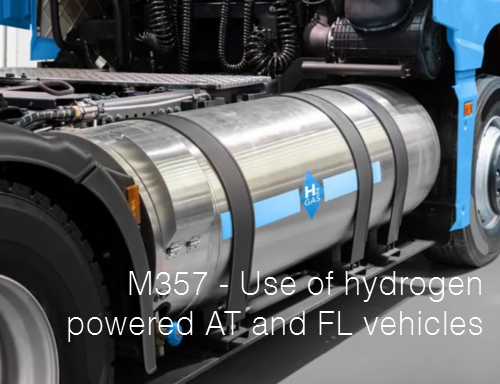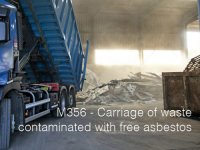M357 - Use of hydrogen powered AT and FL vehicles
| ID 21657 | | Visite: 118 | Accordo Multilaterale | Permalink: https://www.certifico.com/id/21657 |
M357 - Use of hydrogen powered AT and FL vehicles
ID 21657 | 09.04.2024
Multilateral Agreement M357 under section 1.5.1 of ADR concerning the use of hydrogen powered AT and FL vehicles
Initiated by Luxembourg on 4 April 2024 / Valid until 1 July 2025
(1) In derogation to the provisions of part 9 of the ADR, vehicles corresponding to categories AT and FL may use hydrogen combustion engines and hydrogen fuel cells to transport dangerous goods permitted according to 9.1.3, if the following technical requirements in the sections 1 to 5 as applicable are met:
Section 1. Fuel tanks and cylinders
Applicable for AT and FL vehicles.
• Fuel tanks and cylinders for hydrogen shall meet the relevant requirements of UN Regulation No.1341, as amended at least by the 02 series of amendments, or for liquid hydrogen containers the technical provisions of Global Technical Regulation No.13, Amendment 12, part 7;
• Fuel tanks for liquid fuels shall meet the requirements of UN Regulation No.343;
• In the event of any leakage under normal conditions of carriage, the liquid fuel or the liquid phase of a gaseous fuel shall drain to the ground and not come into contact with the load or hot parts of the vehicle;
• The discharge opening(s) of pressure relief devices and/or pressure relief valves of fuel tanks containing gaseous fuels shall be directed away from air intakes, fuel tanks, the load or hot parts of the vehicle and shall not impinge on enclosed areas, other vehicles, exterior-mounted systems with air intake (i.e. air-conditioning systems), engine intakes, electrical storage systems or engine exhaust. Pipes of the fuel system shall not be fixed on the shell containing the load.
Section 2. Internal combustion engine
Applicable for AT and FL vehicles.
The engine propelling the vehicle shall be so equipped and situated to avoid any danger to the load through heating or ignition. The use of a fuel shall only be permitted if components are approved, and installation meet the provisions of 9.2.2 and the technical requirements of UN Regulation No. 134 for compressed hydrogen and the technical provisions of Global Technical Regulation No.13. Amendment 1 for liquid hydrogen, as relevant.
1 UN Regulation No. 134 (Uniform provisions concerning the approval of motor vehicles and their components with regard to the safety-related performance of Hydrogen-Fuelled Vehicles (HFCV))
2 UN Global technical regulation No. 13 on hydrogen and fuel cell vehicles
3 UN Regulation No. 34 (Uniform provisions concerning the approval of vehicles with regard to the prevention of fire risks)
Section 3. Hydrogen Fuel Cell
Applicable for AT and FL vehicles.
Hydrogen Fuel Cell Vehicles shall comply with the requirements for the electrical power train of section 5 of this agreement.
Hydrogen Fuel cell vehicles shall comply with UN Regulation No. 134 series 02 of amendment. For vehicles using liquid hydrogen the technical requirements of the Global Technical Regulation No.13, Amendment 1 applies.
Shut-off devices of hydrogen containers shall close automatically:
• when the vehicle is no longer in driving mode;
• at deceleration of 3.25 m/s2 for 0.7 s;
• in case of lateral overturning above an angle of 23°.
The shut-off devices may be re-opened by a deliberate action of the driver.
Section 4. De-energizing electrical circuits
Applicable only for FL vehicles.
NOTE: Features to enable the de-energization of the electric circuits shall be designed so that they can be operated when the vehicle is stationary.
Features to enable the de-energization of the electrical circuits for all voltage levels shall be placed as close to the energy sources as practicable. In the case the feature interrupts only one lead from the energy source, it shall interrupt the supply lead.
A control device to facilitate the de-energizing shall be installed in the driver's cab. It shall be readily accessible to the driver and be distinctively marked. It shall be protected against inadvertent operation either by adding a protective cover, by using a dual movement control device or by other suitable means. Additional control devices may be installed provided they are distinctively marked and protected against inadvertent operation. If the control devices are electrically operated, the circuits of the control devices are subject to the requirements of 9.2.2.9.
The de-energization shall be completed within 30 seconds after the activation of the control device.
The feature shall be installed in such a way that protection IP65 in accordance with IEC 60529 is complied with.
Cable connections on the feature:
Systems with a voltage that exceed 25 V AC or 60 V DC and systems under the scope of UN Regulation No. 1004, shall comply with the requirements of the said regulation.
4 UN Regulation No. 100 (Uniform provisions concerning the approval of vehicles with regard to specific requirements for the electric power train)
Systems with a voltage up to 25 V AC or 60 V DC shall have a protection degree IP 54 in accordance with IEC 60529. However, this does not apply if these connections are contained in a housing which may be the battery box. In this case, it is sufficient to insulate the connections against short circuits, for example by a rubber cap.
Section 5. Electric power train
Applicable to FL and AT vehicles powered by a hydrogen fuel cell.
5.1. General provisions
Trailers with re-generative braking or electric power train are not allowed.
The electric power train shall meet the requirements of UN Regulation No. 100, as amended at least by the 03 series of amendments.
Vehicles with an electric power train shall be equipped with and isolation resistance monitoring system.
The vehicle shall give external signals in stationary conditions, in addition to the warning to the driver receives in the driver’s cab as required by 6.15.1 of UN Regulation No.100.
5.2. Rechargeable Electrical Energy Storage System (REESS)
NOTE: Other acronyms for “REESS” are used in other documentation for similar systems (e.g. RESS).
REESS of vehicles with an electric power train shall be designed and constructed taking into account a risk evaluation according to ISO 6469-1:2019/Amd 1:2022 to establish safety for normal operational conditions. A review shall be carried out by a technical service such as a technical service for vehicle approvals according to UN Regulation No. 100, as amended at least by the 03 series of amendments.
NOTE: Normal operational conditions includes the normal, malfunctioning and reasonable foreseeable accidental situations.
5.3. Measures against thermal propagation
Applicable only for FL vehicles powered by a hydrogen fuel cell.
REESS containing cells for which thermal propagation cannot be guaranteed to be contained within the REESS, measures shall be taken to mitigate danger to the load by heating or ignition.
5.4. Vehicle charging inlet
Applicable only for FL vehicles powered by a hydrogen fuel cell.
The vehicle charging inlet shall be provided with thermal sensing function which limits or interrupts current transfer according to ISO 17409:2020, when the temperature exceeds
component rated values or required limits by applicable product standards, see e.g. IEC 62196-3-1:2020.
(2) The consignor shall include the following entry in the transport document: “Carriage in accordance with Multilateral Agreement M357”.
(3) This agreement shall be valid until 1st July 2025 for carriage on the territories of those ADR Contracting Parties signatory to this Agreement. If it is revoked before that date by one of the signatories, it shall remain valid until the above-mentioned date only for carriage on the territories of those ADR Contracting Parties signatory to this Agreement, which have not revoked it.
Luxembourg,
The competent authority for ADR in Luxembourg:
Minister for Mobility and Public Works
...
Fonte: UNECE
| Descrizione | Livello | Dimensione | Downloads | |
|---|---|---|---|---|
| M357 - Use of hydrogen powered AT and FL vehicles.pdf |
265 kB | 3 |
Tags: Merci Pericolose Accordi multilaterali Abbonati Trasporto ADR










































